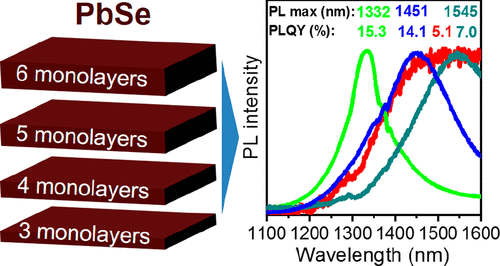In this work, we report a colloidal synthesis of atomically flat PbSe nanoplatelets (NPLs) of different thicknesses from 3 to 6 monolayers via cation exchange from the corresponding CdSe NPLs. In order to preserve the delicate structure of the NPLs, we performed the reaction at mild conditions using a temperature of 80 °C and lead bromide dissolved in oleylamine and octadecene as a Pb precursor. Cation exchange affected the size and the shape of the resulting NPLs depending on their thickness, i.e., the thinnest platelets (3 monolayers) underwent a partial degradation, although retaining their 2D structure, while the thicker ones were etched on their edges. We observed thickness-dependent near-infrared (NIR) photoluminescence (PL) with maxima ranging from 1330 to 1550 nm and quantum yields (PL QY) reaching 15%. The PbSe NPLs exhibited an excellent stability of the optical properties upon their storage in ambient atmosphere for several weeks, which we attribute to an efficient surface passivation with bromide ions or PbBr2 as X- and Z-type ligands, respectively. Moreover, we achieved extremely narrow full width at half-maximum values of their PL spectra down to 80 meV, which in combination with significantly high PL QYs make these nanomaterials excellent NIR emitters for exploitation in NIR light-emitting diodes, lasing, and telecommunications.

In this work, we report a colloidal synthesis of atomically flat PbSe nanoplatelets (NPLs) of different thicknesses from 3 to 6 monolayers via cation exchange from the corresponding CdSe NPLs. In order to preserve the delicate structure of the NPLs, we performed the reaction at mild conditions using a temperature of 80 °C and lead bromide dissolved in oleylamine and octadecene as a Pb precursor. Cation exchange affected the size and the shape of the resulting NPLs depending on their thickness, i.e., the thinnest platelets (3 monolayers) underwent a partial degradation, although retaining their 2D structure, while the thicker ones were etched on their edges. We observed thickness-dependent near-infrared (NIR) photoluminescence (PL) with maxima ranging from 1330 to 1550 nm and quantum yields (PL QY) reaching 15%. The PbSe NPLs exhibited an excellent stability of the optical properties upon their storage in ambient atmosphere for several weeks, which we attribute to an efficient surface passivation with bromide ions or PbBr2 as X- and Z-type ligands, respectively. Moreover, we achieved extremely narrow full width at half-maximum values of their PL spectra down to 80 meV, which in combination with significantly high PL QYs make these nanomaterials excellent NIR emitters for exploitation in NIR light-emitting diodes, lasing, and telecommunications.
